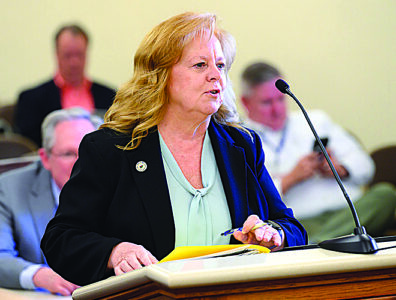Report: West Virginia’s County School Systems Making Strides

photo by: W.Va. Legislative Photography
West Virginia Deputy Superintendent of Schools Sonya White briefs lawmakers Sunday during October legislative interim meetings.
CHARLESTON — An annual report on the condition of West Virginia county school systems both academically and operationally showed some improvement in key areas.
Deputy Superintendent of Schools Sonya White presented the Department of Education’s annual report on County Approval Status and Accreditation during a Sunday afternoon meeting of the Legislative Oversight Commission on Education Accountability on the first day of October legislative interim meetings at the State Capitol Building.
The report, first presented to the state Board of Education last week during its regular monthly meeting, reviews all 55 counties on an annual basis.
County approval statuses, which look back at the previous school year, are assigned based on 11 operational effectiveness efficiency indicators: facilities, finance, personnel, state-required data collections, transportation, special education, universal pre-kindergarten readiness, career and technical education, child nutrition, county board of education member effectiveness, and Elementary and Secondary Education Act programs.
The report also reviews counties based on 11 student performance indicators from the annual West Virginia Balance Scorecard. Designations range from “on watch” for not meeting standards, to “support indicators” for not meeting standards for two years in a row, to “intensive support” for not meeting standards for three years in a row.
“This is based on the state code … for the accountability approval status and accreditation for our schools, and to ensure that each county board of education provides a thorough and efficient education for its students,” White told committee members. “County scorecards and efficiency profiles are reviewed and approval status are determined based on multiple measures of student performance and county operational efficiency.”
According to the report, 29 counties were listed as needing assistance for not meeting one or more of the efficiency indicators, down from 34 in last year’s report. Counties listed as “needs assistance” must work with the Department of Education on action plans to reverse negative trends in their efficiency indicators.
“Nearly half of all our counties met requirements for all of those operational effective indicators,” White said. “Three (categories) that stuck out where counties need assistance were transportation, finance and county board of education member effectiveness…”
Six counties — Boone, Logan, Mingo, Nicholas, Tyler and Upshur counties — are under direct intervention by the state board and Department of Education, so they were issued a non-approval status until acceptable progress is made.
“These counties, because of this designation, are required to create and implement a corrective action plan to address the identified operational challenges,” White said.
When it comes to one of more student performance indicators, 33 of 55 counties were considered “on watch” for not meeting one or more standards in the following areas: English language arts achievement and program, math achievement and progress, English learners progress, attendance, behavior, four-year and five-year graduation rates, students on-track to graduation, and post-secondary achievement.
That is down from 41 counties considered on watch in last year’s report. There were 24 counties in this year’s report listed under “support indicators,” which was down from 35 in last year’s report. But the number of counties listed as needing “intensive support” increased from eight in last year’s report to 14 in this year’s report.
“Math achievement was the most frequently flagged indicator across all categories, and then the report indicates that there’s a reduction in the number of counties identified with ELA (English language arts) achievement from 2024-25,” White said. “Seven districts were identified with on watch for ELA.”
The only counties that met requirements for county operational effectiveness efficiency and had no negative indicators for the Balanced Scorecard and student performance were Hampshire and Ohio.
The number of counties on watch for attendance issues also decreased, from 21 in last year’s report to 14. Another 15 are considered in need of support, down from 20 counties last year. But Pocahontas and Webster counties were listed as needing “intensive support.”
“Attendance is still featured prominently in both ‘on watch’ and ‘support’ designations,” White said. “However, 19 of the 20 districts identified as needing support in the 2024 report showed a reduction in chronic absenteeism for 2025. So overall, the average chronic absenteeism rate statewide has declined from a little over 29% in 2022 to 22.76% this past year.”
The report also includes data for the state’s public charter school system, though the county operational effectiveness efficiency indicators do not apply to those schools. While public charter schools have flexibility when it comes to curriculum and other areas, the state Board of Education still has authority over them when it comes to student performance and proficiency.
Only one school — the Morgantown-based West Virginia Academy — has existed long enough to collect three years of student performance indicators, though it did not trigger any. However, Clarksburg Classical Academy and Eastern Panhandle Preparatory Academy were placed on watch for attendance.
West Virginia’s two statewide virtual charter schools — Virtual Preparatory Academy of West Virginia and West Virginia Virtual Academy — triggered “on watch” and “support” indicators.
The Virtual Preparatory Academy was placed on watch for attendance and on-track to graduation indicators that did not meet standards and listed as needing support for ELA and math achievement for not meeting standards two years in a row. West Virginia Virtual Academy was placed on watch for math achievement and on-track to graduation and listed as needing support for ELA achievement.





